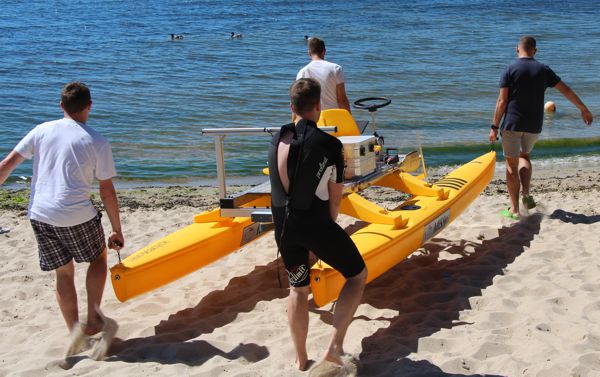Speech and Data Communication under Water
 |
||
| Contents: | ||
 The wireless underwater communication has many civil and military applications and the interest in this field has grown over the last decades. Wireless signal transmission enables the communication with autonomous underwater vehicles (AUV) and roboters. Furthermore, with the help of wireless communication the oceans can be surveyed and monitored.
The wireless underwater communication has many civil and military applications and the interest in this field has grown over the last decades. Wireless signal transmission enables the communication with autonomous underwater vehicles (AUV) and roboters. Furthermore, with the help of wireless communication the oceans can be surveyed and monitored.
Another application is the underwater telephone, which enables the communication with and in between submarines and divers. The conventional techniques for wireless, terrestrial communications cannot be used for the signal transmission underwater, because water as a transmission medium has different characteristics than air. High attenuation and non-linearities like the Doppler effect, multipath-propagation and rising underwater noise leads to a severe decrease in transmission quality, in particular over big distances. The general technique for communication with submarines has not changed much since the second world war.
The recent research tries to improve the signal quality and signal range while complying with the NATO-standards. While the older STANAG (Standardization Agreement) 1074 defines the minimum characteristics of analog underwater telephones, the fairly new STANAG 4748 (April 2017) defines digital underwater signaling. It is based on the open source JANUS protocol which provides a variety of frequencies and bandwithes suitable for any given application and allows many different clients through MAC (Medium Access Control).
In a more general approach to underwater communication, speech communication for swimmers and divers is enabled by special swimming masks and swimming goggles. Currently there are only few technical solutions, which allow divers or swimmers to speak to people outside the water or to get commands from those people. The human speech and hearing organs are not suited for underwater use, so speaking itself needs much effort or skill to accomplish. A student project dealt with a diving mask for communication, which was equipped with waterproof microphones and a WLAN module. Nevertheless it's a full face mask and during a master thesis this idea was pushed a bit further. A set of ordinary swimming goggles was equipped with waterproof microphones and as a first step a speech recognition for commands, spoken directly “into the water“, controlling an MP3 player was built up.
Corresponding Publications:
O. Wisch, G. Schmidt: Mixed Analog-digital Speech Communication for Underwater Applications, Proceedings of the 14th ITG Conference on Speech Communication, September 2021
O. Wisch, G. Schmidt: Nichtlineare Signalverarbeitung für Systeme zur Unterwassertelefonie, Proc. DAGA, Germany, 2019
T. O. Wisch, T. Kaak, A. Namenas, G. Schmidt: Spracherkennung in stark gestörten Unterwasserumgebungen, Proc. DAGA, Germany, 2018

 On behalf of the members of the Chair of Digital Signal Processing and System Theory, we would like to take this opportunity to wish you all a very Merry Christmas and a peaceful, restful winter break. We hope that this festive season brings you joy, relaxation, and cherished moments with your loved ones.
On behalf of the members of the Chair of Digital Signal Processing and System Theory, we would like to take this opportunity to wish you all a very Merry Christmas and a peaceful, restful winter break. We hope that this festive season brings you joy, relaxation, and cherished moments with your loved ones.